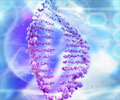A collaborative study conducted by researchers from UC Santa Barbara and several other institutions has provided laboratory that a cluster of peptides may be the toxic agent in Alzheimer's disease.
The researchers believe that the finding made in the laboratory of Michael T. Bowers, a professor of Chemistry and Biochemistry at UCSB, may lead to new drugs for the disease.In their study report, they have explained the process in which the toxic Amyloid Beta 42 peptides aggregate, and outlined the new technology they use to study these peptides.
"We believe that we have put a face, a structure, on the molecular assembly that is responsible for Alzheimer's disease," Nature magazine quoted Bowers as saying.
He and his colleagues used an innovative technology called ion mobility-based mass spectroscopy, a method that allows researchers to investigate the structure, aggregation, and energetics of protein and peptide systems.
The Amyloid Beta (AB) 42 peptide is clipped from a much larger protein, the amyloid precursor protein (APP), and is composed of 42 amino acid residues.
A second peptide, AB40, is 10 times more abundant than AB42 in healthy human brains, and is also clipped from APP. It is identical to AB42 except it is missing the last two amino acids.
Advertisement
Bowers points out that AB40 never grows beyond a tetramer-a cluster of four AB40 peptides. As a consequence, it is nontoxic.
Advertisement
His team say that two of these "six-mer" rings stack to form a dodecamer, or "twelve-mer", and then the aggregation stops.
These dodecamer clusters are long-lived, but may eventually rearrange to form so-called B-sheet structures, which lead to the large fibrils that form the plaques found in the brains of those with Alzheimer's disease and other neurodegenerative diseases.
While experimenting on mice, the researchers observed that the animals implanted with the gene that expresses human APP, and hence able to form AB42 in their brains, quickly developed memory deficits-as if they had Alzheimer's disease.
Since mice have a much faster metabolism than humans, the disease progresses more quickly. Of importance is the fact that the only AB species found in the brains of the transgenic mice correlates with the dodecamer of AB42 characterized in the Bowers lab experiments. These two pieces of data together strongly implicate the dodecamer of AB42 as the toxic agent in Alzheimer's disease.
"Our group, along with our collaborators, are searching for drug candidates that can prevent AB42 from aggregating to form the toxic dodecamer. While it is early in the search, we are hopeful good candidates can be found. As a consequence, there is a need to find an early marker for Alzheimer's disease so that we can use these drugs to radically slow down the disease progression," said Bowers.
Writing about the study in the journal Nature Chemistry, Bowers said that his team's method was new, but was gaining acceptance in the biological community.
He said that to fully understand the disease, effects of the oligomerization process would have to be observed at the cellular level, however.
"These latest results are a very hopeful thing. I'm more hopeful now than I have ever been that we can make some real progress on this terrible disease," said Bowers.
Source-ANI
LIN













